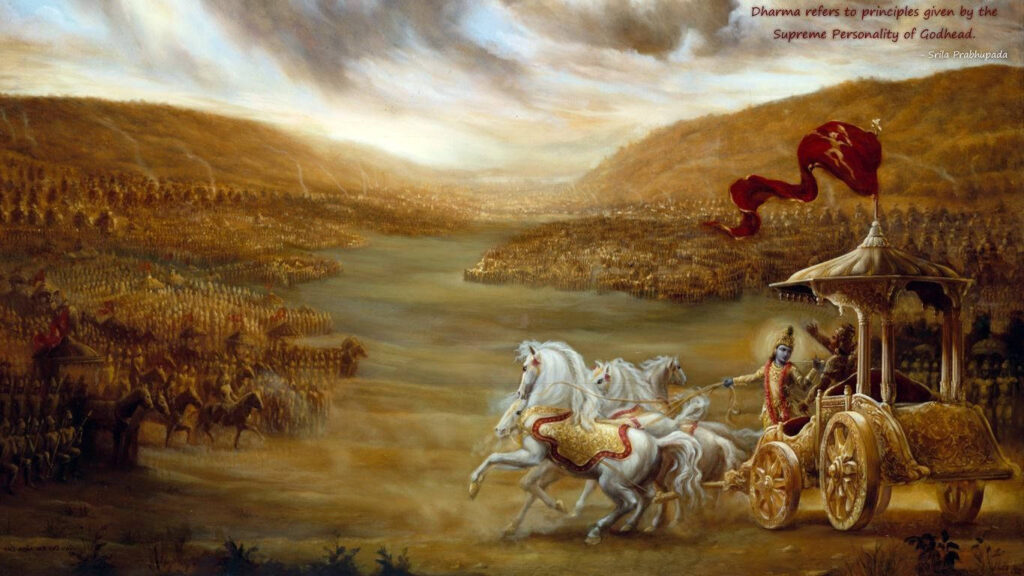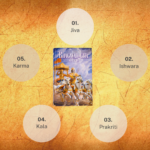Namaste dear readers!
As we continue our journey through the Bhagavad Gita in our Samyak Drishti newsletter, it’s crucial to understand the historical and cultural context in which this powerful conversation took place. It is also important to know for whom and by whom this knowledge was imparted. Today, I am sharing the story that sets the stage for one of the greatest philosophical and spiritual dialogues known to humankind.
The Bhagavad Gita, although widely studied on its own, originally appears as a critical episode in the Mahabharata, the epic Sanskrit history of the ancient world. There are 18 chapters and 700 verses in the Bhagavad Gita which can be found in the Bhishma Parva of Mahabharata. This profound conversation between Lord Krishna and Arjuna occurred at a pivotal moment—just before the onset of a great war between the Kuru dynasty’s cousins: the righteous Pandavas and the ambitious Kauravas, led by Duryodhana.
The Gita was spoken at a time when both armies stood ready for combat, and Arjuna faced a crisis of purpose. Torn between his duty as a warrior and his love for family, friends, and teachers on both sides, Arjuna found himself overwhelmed by moral confusion. At this critical juncture, Lord Krishna—not merely a prince but the Supreme Godhead Himself—offered Arjuna the wisdom that would change not only his perspective but also countless lives for generations to come.
However, the message of the Bhagavad Gita extends beyond the battlefield of Kurukshetra; it is a timeless call for self-realization, moral duty, and devotion. Krishna, the very essence of the Gita, guides us on how to act with righteousness while remaining detached from outcomes—a lesson that continues to be relevant in our lives today.
Debunking Popular Misconceptions about the Gita
There are several misconceptions surrounding the Bhagavad Gita, which often hinder people from experiencing its profound teachings:
- Gita as Just Another Religious Text: Many people mistakenly categorize the Gita alongside other religious texts like the Bible or the Quran. While it is a part of Hindu scripture, the Gita is far more than that—it is a deep philosophy and a science of well-being. Many renowned scientists and philosophers from diverse backgrounds have testified to its universal wisdom and practical value in life.
- Gita is Only for the Elderly: There is a common belief that the Gita should be read only in old age. This could not be further from the truth. It is during our youth, when our brain cells are most adaptive to learning, that we should delve into profound philosophies and sciences. Understanding the principles of life and well-being early on equips us with the right tools to navigate life’s complexities.
- Gita is exclusively a Hindu Text: Another significant misconception is that the Bhagavad Gita is exclusively a Hindu text. This misunderstanding extends not only to the Gita but also to other texts like the Vedas, Upanishads, and other works originating from the Indian Knowledge System. In IKS, concepts such as Engineering, Medicine, Astronomy, Philosophy, Mathematics, and Physics are integrated with ideas of God, Nature, Being, Time, Action, and their interactions. This blending can make these texts appear as purely religious works, especially to individuals from other religions or regions who may carry (i) Conformity biases—trying to fit unfamiliar knowledge into existing frameworks, (ii) Anchoring biases–a pervasive cognitive bias that causes us to rely too heavily on information that we received early in the decision-making process. Even the theological ideas mentioned in the Gita or other IKS texts are quite open ended, not like the theological ideas of Abrahamic or other faiths.
- Gita is Only for Saints/Hermits: Another popular misbelief is that the Gita is meant for saints and is irrelevant for householders. This, too, is misguided. Bhagavad Gita was spoken by Sri Krishna to Arjuna, a householder and warrior—not to a hermit or saint who had renounced all material attachments. It is, therefore, a guiding light for people from all walks of life, especially those balancing worldly responsibilities.
“In the morning I bathe my intellect in the stupendous and cosmogonal philosophy of the Bhagavad Gita, and in comparison with which our modern world and its literature seem puny and trivial”- Henry David Thoreau

Krishna: The Heart of the Gita
It is important to recognize that most translations of the Gita have either diminished the person of Krishna or treated Him as a mere poetic device. In this newsletter series, our goal is to focus on Krishna, who is both the speaker and the essence of the Gita. The Bhagavad Gita is meant to lead us to Him, the Supreme Personality of Godhead, who provides us with timeless wisdom for living a balanced, purposeful life.
“The general pattern translators have followed in rendering Bhagavad-gītā into English has been to brush aside the person Kṛṣṇa to make room for their own concepts and philosophies. The history of the Mahābhārata is taken as quaint mythology, and Kṛṣṇa becomes a poetic device for presenting the ideas of some anonymous genius, or at best He becomes a minor historical personage. But the person Kṛṣṇa is both the goal and the substance of Bhagavad-gītā, so far as the Gītā speaks of itself.”- A. C. Bhaktivedanta Swami Prabhupāda
Join me as we explore the teachings of the Gita, chapter by chapter, reflecting on the deep wisdom imparted by Krishna to Arjuna. Let us see how these teachings can empower us to face our challenges with clarity, courage, and devotion, and enrich our daily lives with purpose.
✨ Subscribe to Samyak Drishti and join this journey of self-discovery and spiritual growth. Let the eternal teachings of the Gita illuminate your path! ✨
References and Source:
- https://vedabase.io/
- What is India? by Salil Gewali
- Valuable inputs from Jyotiranjan Beuria



